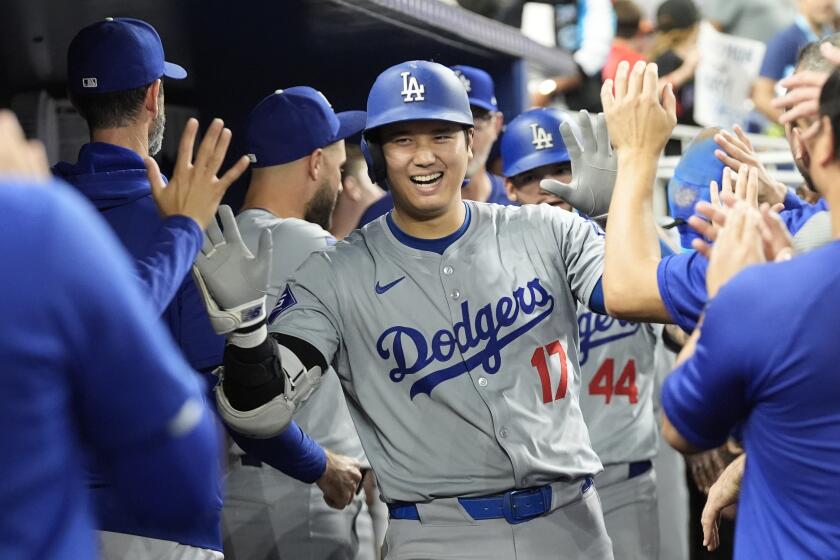Column: James Blake’s incident plays out against backdrop of race issues in tennis, society

James Blake retired from professional tennis after the 2013 U.S. Open.
The weather for this U.S. Open tennis tournament turned sour Thursday. Sadly, so did the mood.
The James Blake story had the kind of stench that has been floating over U.S. law enforcement for all too long now. And it floated out to the tennis center, where there were lots of furrowed brows and shrugs of why?
Blake is a former U.S. tennis star, once No. 4 in the world. He was often a big attraction for his dynamic personality and similar play, especially during this tournament’s famed night sessions. Ten years ago, he took Andre Agassi to five sets and into the wee hours of the morning.
Blake, whose father is African American and mother is white, retired a couple of years ago, but the U.S. Open has always been a magnet for former players, both as broadcasters and corporate spokespeople. They brand themselves as players and, in retirement, cash in on that branding.
About noon Tuesday, Blake was waiting for a car to take him to the U.S. Open and one of those corporate events. Reports said that, as he waited he was tackled by an officer and detained by several New York police, all white, who had mistaken him for a person involved in credit card fraud.
The incident took place outside the same hotel I’m staying at, the Grand Hyatt. I had walked by the spot where Blake was tackled about 15 minutes earlier. He wasn’t there then. I would have seen him.
I wish I had been 15 minutes late and stopped to chat. Maybe they wouldn’t have accosted him. . Maybe the sight of a white guy (me) next to Blake would have given the cops pause. Maybe that’s unfair to say, but recent events in this country compel me to do so.
Blake was eventually recognized and released. Bill Bratton, the New York Police Department chief who had held the same job for the LAPD, has already apologized and the NYPD is in retreat mode. Blake has said all the right things, including the fair assumption there may have been some racial profiling here. In light of recent events, that’s unavoidable.
So is the issue of race and its connection to tennis, especially at this moment.
On one hand, we are celebrating Serena Williams. She is two victories away from a historic Grand Slam. Her match against sister Venus on Tuesday night drew a bigger television audience in New York City than the Yankees and Mets.
It used to be nothing in this city was bigger than the Yankees and Mets in pennant races. Serena was.
Her race has always been part of that story. She has been a smash success in a sport that was once the domain of white people at country clubs. She is straight outta Compton, not Beverly Hills, Kenilworth, Ill., or Miami Beach.
A reporter from the local NPR station called Thursday morning for my comments on Serena. His fourth question, phrased very carefully, was about race. It’s usually the second question.
The tone of the question was that her presence and success had finally brought black America into the sport. I responded it should be noted she will be, if she wins Friday, playing for her historic title in a 22,500-seat stadium, biggest in the world for tennis, named after Arthur Ashe.
You want a black tennis pioneer, cite Ashe.
What Serena and Venus Williams have done is make black players on the tennis tour a yawn, a so-what. James Blake was part of that too. The Williams sisters and Blake continued the process started by Ashe and Althea Gibson, a process that makes it nary a blip on the radar to see black players in the draw.
One of Serena’s toughest matches here was against a young Madison Keys. Keys is black. She is very good. She may be among the brightest future stars of U.S. tennis. When she and Serena played, forehands, backhands and speed of serve were the only story lines.
Ashe would have been thrilled.
Blake went to Harvard before he turned pro. When he did, he was one of the most engaging and brightest personalities on the tour. He was an overachiever, both as a person and a player.
One of the chuckles floating around the media center here, when the news came of his incident with the police, was the part of the story that said he was, at least for the moment, withholding comment. Blake never withheld comment.
The transcription of interview sessions for major sports events, including this one, is done by a group called ASAP. They used to cringe when Blake came to the microphone. Most interview transcripts are one or two pages. Win or lose, Blake’s seldom went less than four.
The New York tabloids screamed the Blake story Thursday morning. They saw it as a big story and also a chance to use clever sports lingo in big, and telling, headlines such as: “GRAND SLAM” and “BAD CALL.” The New York Times played the story inside, as a local event. It hardly seemed that, when considering all the police-minority clashes that have taken place in this country recently.
Parked outside the Grand Hyatt on Thursday morning were half a dozen TV trucks. The assumption was the journalists were waiting for Blake to emerge. While I despise the shallow nature of most broadcast reporting, I welcome the noise here. It will be yet another reminder that we aren’t there yet.
We should hope for three things:
•That Blake continues his smart and restrained reaction to this, realizing the event’s public exposure is more useful than any personal lawsuit.
•That the local media press hard for a copy of the picture the police were using when they targeted Blake. A real resemblance will boost the “unfortunate mistake” contention, and cool things.
•That we are able to see that connecting the dots between the celebration of Serena and the accosting of Blake at the same high-profile sports event is not without merit and is not farfetched.
It’s also troublesome.
Twitter: @DwyreLATimes
More to Read
Go beyond the scoreboard
Get the latest on L.A.'s teams in the daily Sports Report newsletter.
You may occasionally receive promotional content from the Los Angeles Times.











